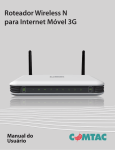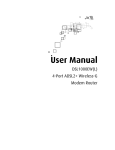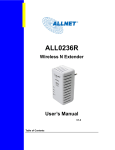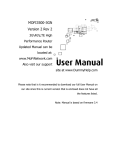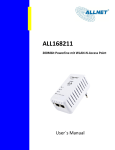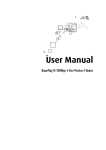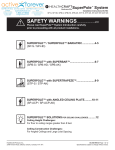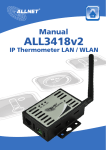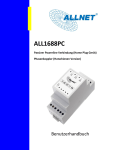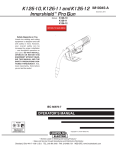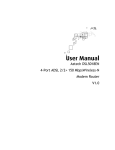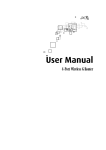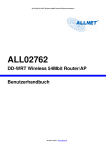Download ALL0239-3G - Allnet.Italia
Transcript
ALL0239-3G Wireless-N Router ALL0239-3G 3G Mobile Broadband plus 4-Port Wireless-N Router User Manual ALLNET GmbH – www.allnet.de User Manual Table of Contents About the Product ................................................................................................................. 3 Features................................................................................................................................ 4 Requirements ....................................................................................................................... 5 Package Content .................................................................................................................. 6 Device Design ....................................................................................................................... 7 Getting Started .................................................................................................................... 10 Plan Your Network................................................................................................... 11 Remove or Disable Conflicts ................................................................................... 12 Installing your Router............................................................................................... 13 Connecting to the Internet ....................................................................................... 14 WPS (Wi-Fi Protected Setup) .................................................................................. 19 Connect/Disconnect Button ..................................................................................... 19 About the Web User Interface ............................................................................................. 20 Basic Mode ......................................................................................................................... 21 Home ...................................................................................................................... 21 Storage ............................................................................................................... 21 Printer ................................................................................................................. 22 Wizard ..................................................................................................................... 32 Quick Setup ............................................................................................................. 35 Advanced Page................................................................................................................... 36 Network ................................................................................................................... 36 Local ................................................................................................................... 36 Internet ............................................................................................................... 37 Wireless .................................................................................................................. 38 Settings ............................................................................................................... 38 Security ............................................................................................................... 39 Applications ............................................................................................................. 39 Port forwarding ................................................................................................... 40 Filtering ............................................................................................................... 40 DDNS (Dynamic DNS) ........................................................................................ 41 System .................................................................................................................... 41 System Information ............................................................................................. 41 Settings ............................................................................................................... 42 Firmware Upgrade .............................................................................................. 42 Reboot ................................................................................................................ 43 Password ............................................................................................................ 44 Regulatory Compliance Notices .......................................................................................... 45 Page 2 of 47 User Manual About the Product ALLNET ALL0239-3G is an IEEE802.11n wireless broadband Router with HSDPA\HSUPA 3.5G support. With a 3G HSDPA USB modem simply plug in the Router, an Internet connection can be accessed and shared virtually anytime anywhere within a wireless broadband network. 4-Port Wireless-N Broadband Router to Share Wireless Internet Connection with more users. ALL0239-3G also integrates router function so that Internet can be accessed through WIFI connection simultaneously. ALL0239-3G 4-port wireless-N router function provides an excellent solution for sharing a wireless Internet connection and files such as High Definition (HD) video, music, photos and documents with the wireless speed up to 300Mbps. Advanced Wireless Security ALLNET ALL0239-3G creates a secure Wi-Fi® network by supporting the latest wireless security features to prevent unauthorized access. It supports for 64/128-bit WEP, WPA, and WPA2 to ensure that you will be able to secure your Wi-Fi network, regardless of your client devices. In addition, the 3G Mobile Router utilizes dual active firewalls (SPI and NAT) to prevent potential attacks from across the Internet. Wide Wireless Coverage The product integrates 2x2 (2 transmit and 2 receive) antennas. This MIMO technology overlay the signals of multiple radios, which successfully reduce “dead sports”, increase throughput and increase wireless coverage range. Easy to install and Use By connecting a HSDPA USB modem into USB port of ALL0239-3G, Internet access can be accessed and shared virtually anywhere within a wire or wireless broadband network. You can also directly connect Ethernet-based devices to its built-in 4-port full-duplex 10/100 switch. Page 3 of 47 User Manual Features 2-in-1 dual function Router - HSPA support for 3G mobile broadband plus 4-port wireless N router Support HSDPA/HSUPA (3.5G) USB modem connection - to offer a network connection with full mobility Converts single user 3G USB modem into a multiple users ready WiFi Router - to share the mobile Internet connection with your family, friends and colleagues Support IEEE802.11b/g and 11n (draft 2.0) wireless standard - data transfer rate reaches up to 300Mbps Support WAN Port and 4-Port 10/100M Ethernet - dual way connections to DSL/Cable modem for Internet access Support for 64/128-bit WEP, WPA, and WPA2 - ensure secure WiFi network, and prevent unauthorized access Support WiFi Protected Setup - reduce by half the user steps to configure a network Adopt 2x2 MIMO technology - increase throughput and increase wireless coverage range Detachable Antennas - allows flexible gain performance antennas. Page 4 of 47 User Manual Requirements Your computer must meet the following minimum requirements. Internet Explorer 7 or Mozilla 3.0.5 CD-ROM Drive Ethernet network adapter Page 5 of 47 User Manual Package Content The package should contain the following items: • ALL0239-3G • CD Content • 12.0V, 1A Power Adapter (Model SWM11-12120) • Easy Start Guide If any of the items is missing please contact the dealer from whom the equipment was purchased. Page 6 of 47 User Manual Device Design Front Panel B C D E A LED A Behavior D E H Description Easy Connect and Disconnect to your 3.5G Connect/Disconnect Button broadband. Power Steady Light C G UMTS 3.5G Off B F No power is supplied to the device. Connected to an AC power source. On UMTS (3.5G) Internet connection is active Off UMTS (3.5G) Internet connection is off On Active USB device is connected to the router Off No active USB device connected to the router On Wireless is enabled Off Wireless is disabled Blinking Transmitting/Receiving data wirelessly 3G USB Wi-Fi Page 7 of 47 User Manual F G On Connected to a Modem Off No Modem connection On Connected to an Active Ethernet Device Off No Ethernet Connection Blinking Transmitting/Receiving Data WAN Ethernet 1-4 Press for two seconds (or until the LED blinks) to H WPS start WPS pairing. Wireless client must be WPS-enabled and must be pressed within 2 minutes. Page 8 of 47 User Manual Back Panel F A B C D E F Label Description A Ethernet Port 1-4 Connecting with computers/devices using an Ethernet cable B WAN Connect to a modem using an Ethernet cable C Reset Press for 3 seconds to reset to the Factory Default. D USB Port E Power Jack Use 12V 1.0A Power Adapter F Antenna 1 and 2 Sending/Receiving wireless signals Connect to a 3G USB modem stick, USB storage, printer and alike. Page 9 of 47 User Manual Getting Started Plan your Network You may need to check Remove/Disable Conflicts some setting or disable some application before installation. Connect the modem, Setup the Router Connect to the Internet Ready to Use Page 10 of 47 computer, and power adaptor to the router. Open a browser to access the Web User Interface and then use Setup Wizard to connect to the Internet. User Manual Plan Your Network 1. Using a 3G USB Modem Stick 2. Using a DSL/Cable modem Page 11 of 47 User Manual Remove or Disable Conflicts To make sure the router installation moves on smoothly, you need to remove or disable conflicts that may interfere the installation. Probable conflicts may include: • Internet sharing applications • Proxy software • Security software • TCP/IP settings • Internet properties • Temporary Internet files Internet Sharing, Proxy, and Security Applications Internet sharing, proxy software, and firewall applications may interfere with the router installation. These should be removed or disabled before start the installation. If you have any of the following or similar applications installed on your computer, remove or disable them according to the manufacturer’s instructions. Internet Sharing Applications Proxy Software Security Software Microsoft Internet Sharing WinGate Symantec WinProxy Zone Alarm Configuring the TCP/IP Settings Check if your computer uses default TCP/IP Settings To check the TCP/IP properties: 1. Click the Start button, and then click Run. This opens the Run dialog box. 2. Type in ncpa.cpl, and then click OK. This opens the Network Connections in your computer. 3. Right-click LAN, and then select Properties. This opens the Local Area Connection Properties dialog box. 4. Select Internet Protocol (TCP/IP), and then click Properties. This opens the Internet Protocol (TCP/IP) dialog box. 5. Select Obtain an IP address automatically. 6. To close the Internet Protocol (TCP/IP) dialog box, click OK. 7. To close the Local Area Connection Properties dialog box, click OK. Page 12 of 47 User Manual Configuring Internet Properties To set the Internet Properties: 1. Click the Start button, and then click Run. This opens the Run dialog box. 2. Type in inetcpl.cpl, and then click Ok. This opens the Internet Properties. 3. Click the Connections Tab. 4. In Dial-up and Virtual Private Network settings, select Never dial a connection. 5. Click Ok the button to close the Internet Properties. Removing Temporary Internet Files Temporary Internet files are files from Web sites that are stored in your computer. Delete these files to clean the cache and remove footprints left by the Web pages you visited. To remove temporary Internet files: 1. Click the Start button, and then click Run. This opens the Run dialog box. 2. Type control, and then click OK. This opens Control Panel. 3. Double-click Internet Options. This opens Internet Options. 4. In the Temporary Internet Files pane, click Delete Cookies. 5. Click Delete Files. 6. To close Internet Properties, click OK. Installing your Router Using a 3G USB Modem Stick If you choose to use a 3G USB Modem Stick you are required to have the following: USB Modem Stick Broadband data SIM card 1. Insert your Broadband data SIM card into the 3G USB Modem stick. 2. Plug in your 3G USB Modem stick on your router’s USB port. 3. Connect the power cable to the router’s power jack and plug it in to the wall socket. 4. Connect your PC to any available Ethernet port using an Ethernet cable or connect via wireless. Page 13 of 47 User Manual Using a DSL or Cable Modem If you choose to use a DSL or Cable modem you are required to have the following: DSL or cable modem Active Internet Account 1. Connect your DSL or Cable modem to the router’s WAN port using an Ethernet cable. 2. Connect the power cable to the router’s power jack and plug it in to the wall socket. 3. Connect your PC to any of available Ethernet port using an Ethernet cable or connect via wireless. Note: Ensure that the router’s IP address does not conflict with the DSL/Cable modem. Please refer to your modem’s User Manual on how to change the LAN IP address. Connecting to the Internet To Connect to the Internet via the Web User Interface: 1. Open your Internet web browser. 2. Type http://192.168.2.1 in the address bar and press enter. This opens the login authentication page. 3. Type your Username and Password. Your default Username and Password is admin/admin. 4. Click the Wizard Tab then Follow the step-by-step guide on how to setup the router. Page 14 of 47 User Manual 5. Select the Language and Time zone from the drop down box then click Next to continue. 6. Select the Internet Connection type then click Next to Continue. If you choose UMTS (3G), you are required to have the following: USB Modem Stick Broadband data SIM card If you choose WAN, you are required to have the following: DSL or cable modem. Active Internet Account 7. UMTS 3G connection Please connect your USB modem stick to ALL0239-3G and make sure that your data SIM card is properly inserted to the modem. 3G Access Point Settings – Choose between List and Manual. List will provide the APN set by your Internet Service Provider. Choose your Country, Internet Service Operator and the APN. Manual you need to manually key in the APN provided by your ISP. Some ISP may require a different name for your APN. Please contact your ISP if you don’t have this information Page 15 of 47 User Manual Username and Password – Some ISP may require a Username and Password set by the Operators. Please contact your ISP if you don’t have this information Choose your preferred Connection Method Connect Manually – This connection method requires you to manually press the ‘Connect’ button each time Internet connection is required. Please note that the Internet connection will not be disconnected unless you manually press the ‘Disconnect’ button. Always connected – This connection method allows your Internet connection to be always ON. You need to manually press the ‘Disconnect’ button when Internet connection is not required. Page 16 of 47 User Manual 8. WAN Connection Please connect your DSL or Cable modem to ALL0239-3G WAN port using an Ethernet cable, make sure that you have an active Internet account. Connection Type Static IP – select this if your ISP provides you the IP address, Subnet mask, Gateway and DNS server addresses. DHCP - if you select this your ALL0239-3G will automatically get an IP address from the DHCP server or from your ISP. PPPoE – select this if your ISP provides you the Username and Password for you to connect to the Internet. Page 17 of 47 User Manual 9. Setup your wireless connection, tick Wireless Enabled to activate your wireless connection and set the SSID for your ALL0239-3G. Click Next to continue. 10. Under Summary page verify the settings made then click ‘Apply’ for the settings to take effect. Page 18 of 47 User Manual WPS (Wi-Fi Protected Setup) WPS button allows you to activate Wi-Fi Protected Setup (WPS). When you press the WPS button it automatically detects and connects wireless clients into the wireless network by broadcasting the wireless network settings from your Access Point to you wireless device/s. To setup WPS: 1. Press the WPS button on the router for two seconds, or until the LED blinks 2. Within 2 minutes, press the WPS button on the Wireless Client. Note: WPS can only be used with wireless client devices that have a compatible WPS component. Connect/Disconnect Button Connect/Disconnect button allows you to connect/disconnect to the Internet using your 3.5G mobile broadband. To Setup Connect/Disconnect Button: 1. Press the Connect/Disconnect button for 2 seconds to change the current status of your 3.5G mobile broadband Internet connection. Note: This button only applies for UMTS 3.5G Internet Connection type. Page 19 of 47 User Manual About the Web User Interface To Access the Web User Interface When you router is already setup open your Web Browser and on the Address bar type in http://192.168.2.1 Username: admin Password: admin The WEB GUI includes the following settings for your router: • • Basic Mode o Home Page o Installation Wizard o Quick Setup Advanced Mode Page 20 of 47 o Networking o Wireless o Application o Maintenance User Manual Basic Mode Home Internet Connection This pane will show you the Internet connection type and status of your ALL0239-3G. Local Network This pane will show you the lists of the clients that are connected to your ALL0239-3G. Storage This pane will show you the status of the mass storages that is connected to your ALL02393G. Select the Read/Write option on the drop down menu to have an access on your shared mass storage files. Accessing the USB Mass Storage Devices 1. Connect the USB Mass Storage on your ALL0239-3G USB port. 2. On your PC click on the Start Button>Run>type \\192.168.2.1 then click OK. 3. Samba Server window will open double click the icon folder to open the files. Page 21 of 47 User Manual Printer This pane will show you the printer that is connected to your ALL0239-3G. Print Server To use the print server on the ALL0239-3G, you need to accomplish the following tasks: 1. Install the printer drivers on the computer 2. Connect the printer to your ALL0239-3G. 3. Add a network printer INSTALL THE PRINTER DRIVERS Printers using the USB port come with a software installation CD for installing the printer drivers and applications. The drivers for the printers must be installed on the computer first to prepare it to use the printer when it’s connected to the ALL0239-3G. Refer to the printer’s documentation on how to install the drivers. ADD A NETWORK PRINTER FOR WINDOWS XP Before you continue, ensure that you have installed the printer’s driver on this computer and the printer is attached to the ALL0239-3G. 1. Click on the Start Button > Control Panel > Printers and Other Hardware > Printers and Faxes. Page 22 of 47 User Manual 2. Click on the File Menu > Add Printer. 3. Click on Next on the Add Printer Wizard page. 4. Choose Local Printer attached to this computer and click Next, on the Local or Network Printer page. Page 23 of 47 User Manual 5. Choose Create a new port and on the drop down box choose Standard TCP/IP Port then click Next. 6. Click Next button on Welcome to the Add Standard TCP/IP Printer Port Wizard. 7. Enter your ALL0239-3G’s Default Gateway IP address 192.168.2.1 then click Next. Page 24 of 47 User Manual 8. Under Additional Port Information Required choose Custom then click Next 9. Once the computer detects the printer on the Print Server, it will ask for the printer manufacturer and model, a list of printers will be shown, select the your printer from the list and click OK. 10. Choose Keep existing driver (recommended) then click Next until you reach Completing the Add Printer Wizard. Page 25 of 47 User Manual 11. Click Finish to complete the installation. PRINTING A TEST PAGE AFTER INSTALLATION 1. Open the Printers and Faxes page from Control Panel. 2. Right click on the new printer and click on Properties. 3. Click on the Print Test Page button on the Printer properties page, the test page will be printed on the network printer. FOR WINDOWS VISTA 1. Click on the Start Button> Control Panel. 2. Click Printer under the Hardware and Sound category. Page 26 of 47 User Manual 3. Click on Add a Printer. 4. Click on Add a local printer then click Next. Page 27 of 47 User Manual 5. Select Create a new port, on the drop down box choose Standard TCP/IP port then click Next. 6. Enter the Default Gateway IP address of your ALL0239-3G router 192.168.2.1 then click Next. Page 28 of 47 User Manual 7. Under Additional Port Information Required window, select Custom then click Next. 8. Once the computer detects the printer on the Print Server, it will ask for the printer manufacturer and model, a list of printers will be shown, select the your printer from the list and click OK. Page 29 of 47 User Manual 9. Select Use the driver that is currently installed then click Next. 10. To print a test page click on Print a test page on the confirmation screen, click Finish to complete the installation. Page 30 of 47 User Manual 11. If Printing was unsuccessful right click on the Printer’s icon then select Properties. 12. Under printer’s Properties click Port Tab and tick the IP address (192.168.2.1) that was set on previous settings then click Apply. Note: Scanning, Faxing and Photocopying functions on Multifunction printers are currently not supported on the ALL0239-3G, Print function is the only feature that will work on these printers type when connected to the ALL0239-3G. Page 31 of 47 User Manual Wizard This section will guide you on how to configure your ALL0239-3G to have an Internet connection. Language and Time Zone Select the Language and Time zone from the drop down box then click Next to continue. Internet Connection Type Select the Internet Connection type then click Next to Continue. If you choose UMTS (3.5G), you are required to have the following: 1. USB Modem Stick 2. Broadband data SIM card If you choose WAN, you are required to have the following: 1. DSL or cable modem. 2. Active Internet Account UMTS (3G) connection 1. 3G Access Point Settings –Choose between List and Manual. • List (recommended) will provide the APN set by your Internet Service Provider. Choose your Country, Internet Service Operator and the APN. • Manual you need to manually key in the APN provided by your ISP. Some ISP may require a different name for your APN. Please contact your ISP if you don’t have this information • Username and Password – Some ISP may require a Username and Password set by the Operators. Please contact your ISP if you don’t have this information 2. Choose the your preferred Connection Method Page 32 of 47 User Manual • Connect Manually – you need to press the Connect button each time Internet connection is required. • Always connected – Internet connection is always ON. You need to manually press the disconnect button when Internet connection is not required. WAN connection On this section you can choose your Internet connection type from Static IP, PPPoE and DHCP. 1. Static IP Select this Internet connection type if your ISP provides the IP addresses that are required to establish a connection. a.) IP Address - Enter the IP address provides by your ISP. b.) Subnet Mask - Enter the Subnet Mask provides by your ISP. c.) Default Gateway - Enter the Default Gateway provides by you r ISP. d.) Primary DNS - Enter the Primary DNS server IP address provides by your ISP. e.) Secondary DNS - Enter the Secondary DNS server IP address provides by your ISP. 2. DHCP Select this Internet connection type for your router to get an IP address from your ISP or the DHCP server. a.) Host name - Some ISP requires the host name of your router. You can change the current hostname of your router. b.) MAC clone - Some ISP requires that you register the MAC address of your computer. Tick the box to copy your PC’s MAC address. c.) MAC Address - This is the computer’s MAC address that is running the router. 3. PPPoE Select this Internet connection type if you’re ISP provides you a username and password to establish a connection. a.) Username - Enter the username provides by your ISP b.) Password - Enter the password provides by your ISP Note: Please contact your Internet Service Provider if you do not have this information. Page 33 of 47 User Manual Wireless This section allows you to configure your basic wireless settings. a.) Wireless Enabled - Uncheck the box to disable your wireless connection. b.) Broadcast SSID Enabled - Uncheck the box to hide your ALL0239-3G wireless network name. c.) SSID - this is your ALL0239-3G wireless network name. d.) WPA Enabled - tick the box if your want to enable your wireless security. This will ensure wireless security on your network. e.) Passphrase - Enter the password that is required by your ALL0239-3G to connect via wireless. Summary This section will display the entire configuration that was set on your ALL0239-3G. 1. Language and Time Zone This pane displays the time that you set on your ALL0239-3G. 2. UMTS (WWAN)/WAN This pane displays the Internet connection type that was set on your ALL0239-3G. 3. Wireless This pane displays the basic settings of your ALL0239-3G wireless connection. Click the Finish button for your settings to take effect. Page 34 of 47 User Manual Quick Setup This section allows you to change the current settings of your ALL0239-3G without going to the step-by-step procedure on how to establish an Internet connection. Language and Time Zone This pane displays the time that you set on your ALL0239-3G. Configure the settings then click the Apply button for the changes to take effect. UMTS (3.5G)/WAN This pane displays the Internet connection type of your ALL0239-3G. You can choose between UMTS (3.5G) and WAN connection. Configure the settings then click the Apply button for the changes to take effect. Wireless This pane displays the current Wireless settings of your ALL0239-3G. Configure the settings then click the Apply button for the changes to take effect. Page 35 of 47 User Manual Advanced Page Network Local This section allows you to configure your local network connection. • Router IP Address – this is the router’s default gateway. Use this IP address to access the router’s Web GUI by enter IP address on the Internet explorer bar. • Router Subnet Mask – this is the router’s subnet mask. • DHCP Enabled- Your ALL0239-3G has a built in DHCP server. Your ALL0239-3G will automatically assign an IP address to all the computers that will connect to your network. Check the TCP/IP settings of your computer and make sure to set it on “Obtain an IP automatically”. Note that when you uncheck the button it will disable the DHCP server. You need to have another DHCP server or you need manually set the IP address of the computer when your DHCP is disabled. • Start IP Address- This field specifies the first of the IP addresses in the IP address pool. • End IP Address- This field specifies the last of the IP addresses in the IP address pool. • Subnet Mask- Enter the Subnet Mask provides by your ISP. • Primary DNS Server- Enter the Primary DNS server IP address provides by your ISP. • Secondary DNS Server- Enter the Secondary DNS server IP address provides by your ISP. • Default Gateway- Recommend to use the router’s LAN port IP address. • Lease Time (sec)- this is the amount of time in which the user is allowed to use the current dynamic IP address. Page 36 of 47 User Manual Internet This section allows you to choose the Internet connection type that you would like to use. UMTS (3G) 1. 3G Access Point Settings –Choose between List and Manual. List will provide the APN set by your Internet Service Provider. Choose your Country, Internet Service Operator and the APN. Manual you need to manually key in the APN provided by your ISP. Some ISP may require a different name for your APN. Please contact your ISP if you don’t have this information 2. UMTS Connection Method • Connect Manually – you need to press the Connect button each time Internet connection is required. • Always connected – Internet connection is always ON. You need to manually press the disconnect button when Internet connection is not required. • Dial Number- Enter the dial number provides by your ISP to establish a connection. Different ISP uses different dial number. Please contact your ISP if you don’t have this information. • Username – Enter the username provides by your ISP. • Password – Enter the password provides by your ISP. • SIM PIN – Enter the SIM PIN that you set on your SIM card on the required field. Some broadband SIM card requires a PIN to unlock the SIM broadband account. Note: Please contact your Internet Service Provider if you do not have this information. WAN Static IP Select this Internet connection type if your ISP provides the IP addresses that are required to establish a connection. • IP Address: Enter the IP address provides by your ISP. • Subnet Mask: Enter the Subnet Mask provides by your ISP. • Default Gateway: Enter the Default Gateway provides by you r ISP. • Primary DNS: Enter the Primary DNS server IP address provides by your ISP. • Secondary DNS: Enter the Secondary DNS server IP address provides by your ISP. DHCP Select this Internet connection type for your router to get an IP address from your ISP or the DHCP server. • Host name: Some ISP requires the host name of your router. You can change the current hostname of your router. Page 37 of 47 User Manual • MAC clone: Some ISP requires that you register the MAC address of your computer. Tick the box to copy your PC’s MAC address. • MAC Address: This is the computer’s MAC address that is running the router. PPPoE Select this Internet connection type if you’re ISP provides you a username and password to establish a connection. • Username: Enter the username provides by your ISP • Password: Enter the password provides by your ISP Wireless Settings This section allows you to configure your basic wireless settings. • Wireless Enabled- Uncheck the box to disable your wireless connection. • SSID- this is your ALL0239-3G wireless network name. • Broadcast SSID- Uncheck the box to hide your ALL0239-3G wireless network name. • Wireless Mode – select the wireless connection mode on the drop down menu list. By default it is set to mixed mode. • Channel- On the drop down box, choose the operating frequency that you would like to use. By default it is set to channel 6. If you notice a lot of interference it is advisable to change the channel. Page 38 of 47 User Manual Security This section allows you to set the wireless security setting of your network. Select the wireless security that you would like to set on your ALL0239-3G on the drop down menu lists. • None Select this if you want your wireless security to be disabled, it is advisable to Enable your wireless security to avoid unauthorized access to your network via wireless. • WEP Set the WEP key on the required field. This is the password that your ALL0239-3G will require to connect to it via wireless. WEP default key You may choose from Hex to ASCII key format for your WEP key. WEP Key 1-4 Select the WEP that you will use to establish a connection between the router and client. Make sure that the WEP key will match on your wireless client’s side. Enter the password in HEX (hexadecimal - using characters 0-9, A-F) or ASCII (alphanumeric characters) format. • WPA; WPA2; WPA/WPA2 Enter the password in the required field between 8-63 characters long. • TKIP; AES; TKIP/AES Choose the encryption that you would like to use. By default it is set to TKIP. Applications Page 39 of 47 User Manual Port forwarding Multiple connections are required by some applications, such as Internet games, video conferencing, Internet telephony, and others. These applications have difficulties working through NAT (Network Address Translation). This section is used to open multiple ports or a range of ports in your router and redirect data through those ports to a single PC on your network. You can enter ports in various formats: 1. Rule Name – enter the rule name in the Rule Name box. 2. IP Address - enter the local network IP address of the device that you would like to port forward. 3. Port Range – enter the port number that you would like open on the required field 4. Protocol – choose the protocol that you would like to open then click Apply for the settings to take effect. Filtering This section allows you to configure MAC filtering, IP filtering and URL filtering. By default ALL0239-3G will block all the MAC Addresses, IP Addresses and URL from accessing the specific rule/port set on the router. MAC Address Filtering This section enables both Port and MAC filtering. MAC filtering allows you to assign different network access based on the unique MAC addresses of the devices connected to the router. 1. On the Filter Type drop down box select MAC Address Filtering. 2. Enter the MAC address of the device that you would like to filter. 3. Enter the Rule name on the required field (example Bob’s PC). 4. Choose the protocol that you would like to filter. 5. Enter the port number in the required field. Click Apply for the settings to take effect. IP Filtering This section enables both Port and IP filtering. IP filtering allows you to assign different network access based on the IP addresses of the devices connected to the router. 1. On the Filter Type drop down box select IP Address Filtering. 2. Enter the IP address of the device that you would like to filter. 3. Enter the Rule name on the required field (example Bob’s PC). 4. Choose the protocol that you would like to filter. 5. Enter the port number in the required field. Click Apply for the settings to take effect. Page 40 of 47 User Manual Note: All incoming access on your network is blocked. If you want to have an access within your network from WAN please use Port Forwarding. URL Filtering This section allows you to control the access to a certain Websites on the Internet by entering URL name on the required field. 1. Enter the domain name on the URL address field (www.xxx.com or www.xxx.net). Click Apply for the settings to take effect. DDNS (Dynamic DNS) DDNS allows you to assign a fixed domain and host name to a dynamic Internet IP addresses. 2. Choose your DDNS service provider from the drop down box. 3. Enter the username of your DDNS account. 4. Enter the password of your DDNS account. 5. Enter the Domain Name that you received from the Dynamic DNS provider (xxx.domainmame.com). Click Apply for the settings to take effect. System System Information This section shows the current firmware information and the router’s MAC addresses. Page 41 of 47 User Manual Settings This section allows you to Back up, Save and Restore to factory default the router’s configuration. Backup Click the ‘Backup’ button to save the current settings of your router. If you will change the current configuration of your HW500-3G it is recommended that you backup the router’s current settings. Restore Click the browse button and select the saved configuration setting of the router then click ‘Restore’. This allows you to load the restored configuration file of your router. Restore to factory default Click the ‘Reset” button to reset the router’s configuration back to its Factory Default settings. Firmware Upgrade This section allows you to upload the latest firmware for your router. Please make sure that you download the correct firmware from the product support website. Page 42 of 47 User Manual Reboot Click the ‘Reboot’ button to reboot the device Page 43 of 47 User Manual Password This section allows you to change the default password setting of the router to access the Web GUI. Enter the new password then click apply. Page 44 of 47 User Manual Regulatory Compliance Notices European Regulations The product has been designed, tested and manufactured according to the European R&TTE directive 1999/5/EC. Page 45 of 47 User Manual EC – Declaration of conformity 04.11.2009 For the following product ALL0239-3G 3G-Mobile Broadband plus 4-Port Wireless-N Router This equipment conforms with the requirements of the Council Directive R&TTE 1999/5/EC on the approximation of the laws of the member states relating to Radio and Telecommunication Terminal Equipment and the mutual recognition of their conformity. The safety advice in the documentation accompanying the products shall be obeyed. The conformity to the above directive is indicated by the CE sign on the device. The ALL0239-3G 3G-Mobile Broadband plus 4-Port Wireless-N Router conforms to the European Directives 1989/336/EEC. This equipment meets the following conformance standards: EN 300 328 EN 301489-1 EN 301489-17 EN 60950-1:2006 V1.7.1 2006-10 V1.6.1 2005-9 V1.2.1 2002-8 This equipment is intended to be operated in all countries. This declaration is made by ALLNET Computersysteme GmbH Maistraße 2 82110 Germering Germany and can be downloaded from http://www.allnet.de/ce-certificates/ Page 46 of 47 User Manual Copyright © 2009. All rights reserved. No part of this document may be reproduced, republished, or retransmitted in any form or by any means whatsoever, whether electronically or mechanically, including, but not limited to, by way of photocopying, recording, information recording, or through retrieval systems without the express written permission of the owner. Product specifications contained in this document are subject to change without notice. All other company or product names mentioned are used for identification purposes only and may be trademarks of their respective owners. Manufacturer: ALLNET GmbH ALLNET Deutschland GmbH Maistrasse 2 82110 Germering Tel. +49 89 894 222 22 Fax +49 89 894 222 33 E-Mail: [email protected] Page 47 of 47

















































